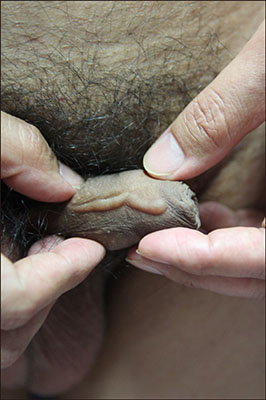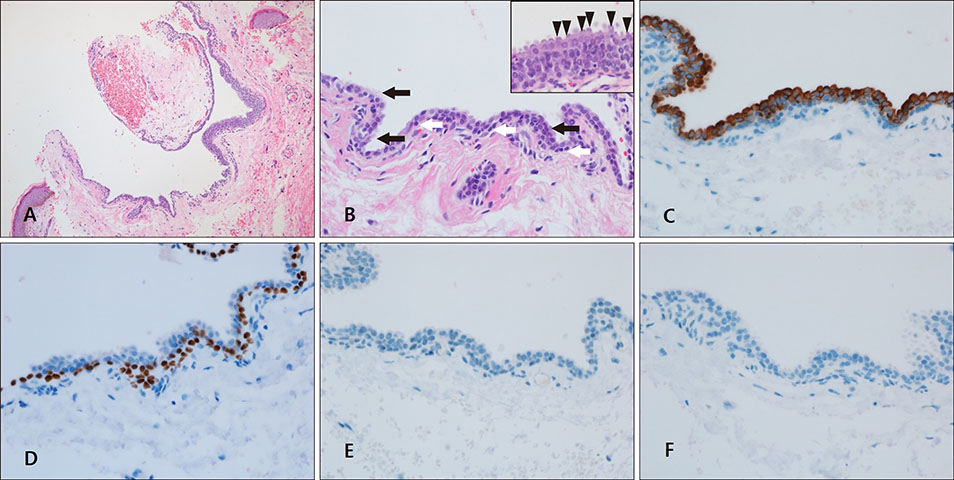Ann Dermatol.
2019 Aug;31(4):442-445. 10.5021/ad.2019.31.4.442.
Apocrine Hidrocystoma on the Penis: Report of a Case and Review of the Previous Cases
- Affiliations
-
- 1Department of Dermatology, Gyeongsang National University School of Medicine, Jinju, South Korea. dr7123@hanmail.net
- 2Department of Pathology, Gyeongsang National University School of Medicine, Jinju, South Korea.
- KMID: 2451483
- DOI: http://doi.org/10.5021/ad.2019.31.4.442
Abstract
- Apocrine hidrocystoma, also called apocrine cystadenoma, is a benign cystic tumor-like lesion that arises from the proliferation of apocrine glands. Clinically, it usually occurs singly as a unilocular or multilocular, dome-shaped translucent cyst. Histologically, it appears as unilocular or multilocular cysts composed of an inner layer of single or double layer of secretory columnar epithelium with decapitation secretion lying above an outer myoepithelial cell layer. Apocrine hidrocystomas mostly occur within the head and neck region and involvement of genitalia is extremely rare. This paper emphasizes the importance of considering the differential diagnosis of a genital cystic lesion. Herein, we report a case of apocrine hidrocystoma occurring in the penis and compare the clinicopathological characteristics of apocrine hidrocystoma in genitalia with the previous cases.
Keyword
MeSH Terms
Figure
Reference
-
1. Kikuchi K, Fukunaga S, Inoue H, Miyazaki Y, Ide F, Kusama K. Apocrine hidrocystoma of the lower lip: a case report and literature review. Head Neck Pathol. 2014; 8:117–121.
Article2. Mehregan AH. Apocrine cystadenoma; a clinicopathologic study with special reference to the pigmented variety. Arch Dermatol. 1964; 90:274–279.3. Samplaski MK, Somani N, Palmer JS. Apocrine hidrocystoma on glans penis of a child. Urology. 2009; 73:800–801.
Article4. Ahmed A, Jones AW. Apocrine cystadenoma. A report of two cases occurring on the prepuce. Br J Dermatol. 1969; 81:899–901.
Article5. Powell RF, Palmer CH, Smith EB. Apocrine cystadenoma of the penile shaft. Arch Dermatol. 1977; 113:1250–1251.
Article6. de Dulanto F, Armijo-Moreno M, Camacho Martinez F. [Nodular hidradenoma (apocrine cystadenoma) of the penis]. Ann Dermatol Syphiligr (Paris). 1973; 100:417–422. French.7. Flessati P, Camoglio FN, Bianchi S, Fasoli L, Menghi A. [An apocrine hidrocystoma of the scrotum. A case report]. Minerva Chir. 1999; 54:87–89. Italian.8. Glusac EJ, Hendrickson MS, Smoller BR. Apocrine cystadenoma of the vulva. J Am Acad Dermatol. 1994; 31(3 Pt 1):498–499.
Article9. Mataix J, Bañuls J, Blanes M, Pastor N, Betlloch I. Translucent nodular lesion of the penis. Apocrine hidrocystoma of the penis. Arch Dermatol. 2006; 142:1221–1226.10. Liu YS, Wang JS, Li TS. A 25-year-old man with a domeshaped translucent nodule on the glans penis. Dermatol Sin. 2010; 28:177–178.
Article11. López V, Alonso V, Jordá E, Santonja N. Apocrine hidrocystoma on the penis of a 40-year-old man. Int J Dermatol. 2013; 52:502–504.
Article12. Park J, Kim I, Jang HC, Chae IS, Park K, Kim Y, et al. Linear skin-coloured papules on scrotum: a quiz. Apocrine hidrocystoma. Acta Derm Venereol. 2015; 95:762–763.13. Taylor D, Juhl ME, Krunic AL, Sidiropoulos M, Gerami P. Apocrine hidrocystoma of the urethral meatus: a case report. Acta Derm Venereol. 2015; 95:376–377.
Article14. Vani D, T R D, H B S, M B, Kumar HR, Ravikumar V. Multiple apocrine hidrocystomas: a case report. J Clin Diagn Res. 2013; 7:171–172.15. Sarabi K, Khachemoune A. Hidrocystomas--a brief review. MedGenMed. 2006; 8:57.16. Ohnishi T, Watanabe S. Immunohistochemical analysis of cytokeratin expression in apocrine cystadenoma or hidrocystoma. J Cutan Pathol. 1999; 26:295–300.
Article17. Persec Z, Persec J, Sovic T, Rako D, Bacalja J, Hrgovic Z, et al. Median raphe cyst–clinical report and immunohistochemical analysis. J Clin Exp Dermatol Res. 2013; S6:011.
Article18. Deliktas H, Sahin H, Celik OI, Erdogan O. Median raphe cyst of the penis. Urol J. 2015; 12:2287–2288.19. Dini M, Baroni G, Colafranceschi M. Median raphe cyst of the penis: a report of two cases with immunohistochemical investigation. Am J Dermatopathol. 2001; 23:320–324.



